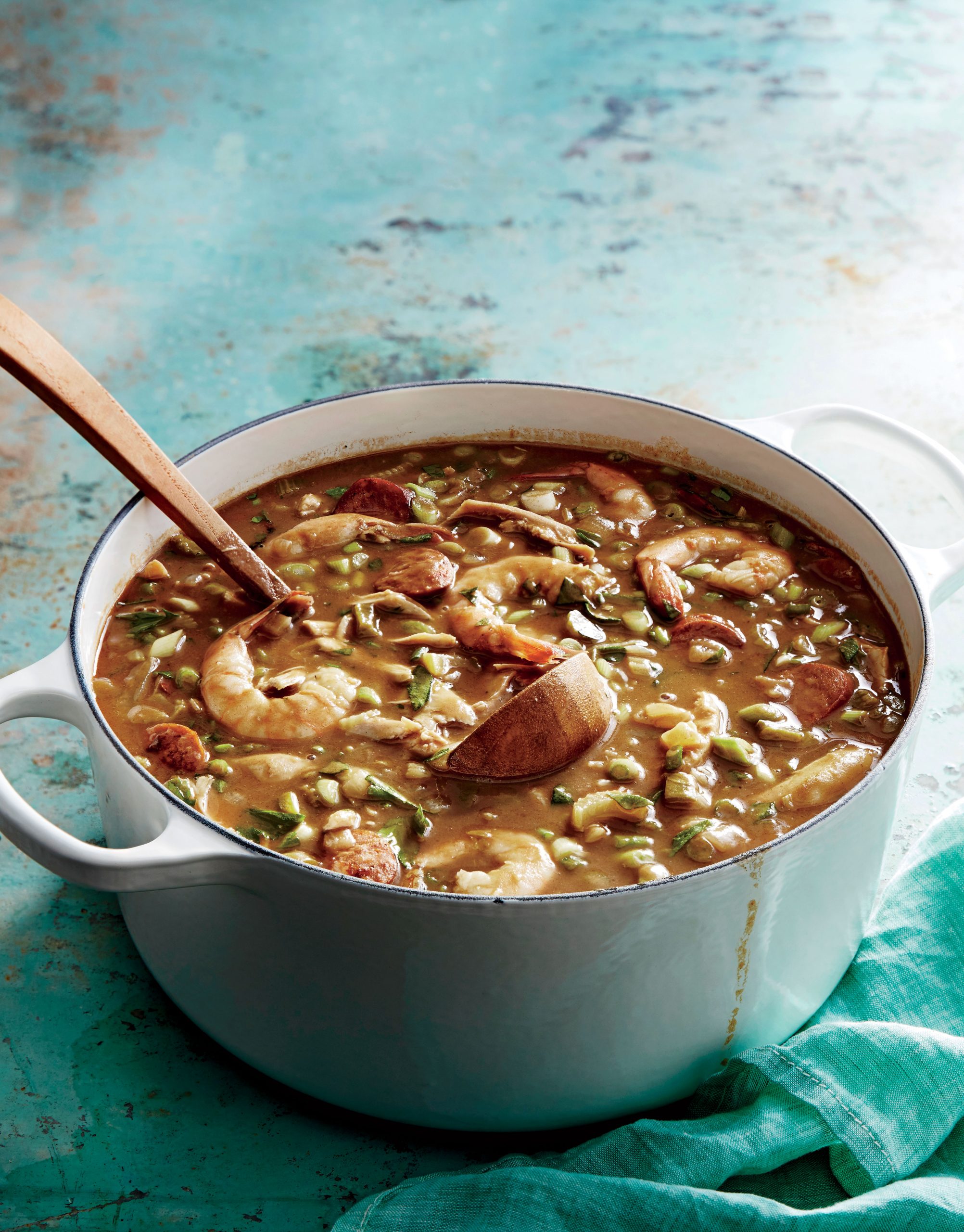
Ingredients
1 whole chicken (about 2 pounds cooked meat)
6 bay leaves
1 pound ground andouille sausage or any good quality smoked sausage, sliced into 1/8 inch thick rounds
2 large onions, coarsely chopped
1 medium head celery, coarsely chopped including leaves
3/4 cup vegetable oil or bacon grease
1 cup all purpose flour
8 cups chicken stock, heated
1 tablespoon salt
2 teaspoons black pepper
1 tablespoon dried thyme
1 teaspoon dried oregano
½ teaspoon dried sage
1 tablespoon LuLu’s Crazy Creola seasoning (or any Creole seasoning you like)
2 tablespoons Worcestershire sauce
2 cups finely chopped green onions
½ cup finely chopped fresh parsley
1 quart fresh oysters, drained
2 pounds medium shrimp, peeled and deveined
2-3 tablespoons LuLu’s perfect pepper hot sauce (or any hot sauce you like)
Filé powder, optional
- Place whole chicken in a large stock pot. Cover with water, add 2 bay leaves, and boil chicken until tender. Remove from broth and cool.
- Remove and discard chicken skin and bones. Chop chicken into large bite-size pieces. Set aside.
- Heat a cast iron or heavy skillet and cook sausage over medium heat until browned. Drain on paper towels.
- Place chopped onions, bell peppers, and celery including leaves, in separate bowls. Set aside.
- To make the roux, heat vegetable oil or bacon grease in a 10-quart heavy stock pot over medium-high heat. When oil is hot, gradually add flour, whisking continuously. Continue to whisk roux, adjusting heat as necessary to keep from burning. This may take 25 to 35 minutes or until your arm feels like it is about to fall off and the roux is a dark mahogany color. Be careful; if the roux burns, you will have to start all over again!
- Carefully add chopped onions to roux and continue stirring with a large wooden spoon for 2 to 3 minutes. Onions will sizzle and steam when they hit the hot roux, so caution is advised. Seasoned gumbo cooks have real battle scars on one or both arms.
- Add bell peppers and continue stirring for another 2 to 3 minutes; add celery continuing to stir constantly for another 2 to 3 minutes. The mixture should now resemble a pot of black beans.
- Add chicken and sausage and stir well.
- Slowly add heated stock and stir well.
- Add salt, black pepper, thyme, 4 bay leaves, oregano, sage, Creole seasoning, and Worcestershire sauce. Stir well. Bring gumbo to a boil and continue boiling for five minutes. Reduce heat to maintain a slow simmer, uncovered, for about one hour or an entire day. If gumbo gets too thick, add a little water. If it is too thin, continue to simmer uncovered. Because there is pork sausage in this gumbo skim off any excess oil that rises to the top.
- At this point, you can cool the gumbo. It’s always better the day after it has been cooked, although I’ve never had a complaint when I served gumbo the day I made it. Remove from heat and let it sit for about 30 minutes. Then place pot, uncovered in an empty sink. Fill the sink with water and ice around the stock pot. Stir gumbo every 15 minutes to move the liquid around to facilitate cooling. Gumbo will spoil if cooled improperly. At the restaurant, we have cooling cylinders that look like baseball bats that are frozen and placed in the middle of 5-gallon stock pots. When completely cool, refrigerate it, uncovered for a couple of hours before placing it in an airtight container.
- Reheat gumbo slowly to simmering. 30 minutes before serving, add green onions and parsley. Cover and cook for 15 minutes. Add oysters and shrimp. Continue simmering for two minutes or until oysters begin to curl.
- For a spicy flavor, add hot sauce. Remove from heat and cover. Let sit for 10 minutes. It will stay hot for a long time. Adjust seasonings and serve over cooked white rice with file powder and French bread and butter.
LuLu’s Clue: filé powder is a flavoring and thickening agent for gumbo made out of the ground leaves of sassafras trees, abundant along the Gulf Coast. Okra was not available in the winter in Louisiana, so the Cajuns, who learned from the Choctaw Indians, used filé powder in their gumbos. Filé is always added at the end of cooking since it can become stringy if boiled. Since I always make enough gumbo to feed an army, I put the filé powder on the table for individual serving.
If you make the winter gumbo, let me know how it goes. I always love to hear of other people’s adventures in gumbo!
All my “GumboLove”,
LuLu
*Winter Gumbo excerpted from my cookbook LuLu’s Kitchen



